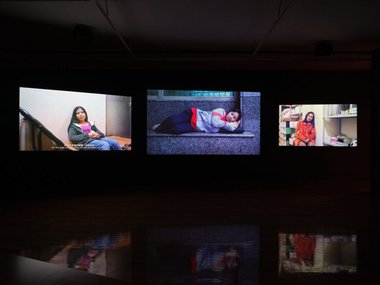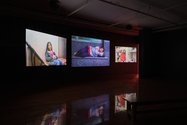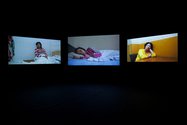John Hurrell – 27 September, 2023
Most of the kinds of intense stress are about the welfare of loved ones and the opinions of those who are now dead, or various economic or employment difficulties. Sometimes in the dream the good intentions of family or religious communities go awry. Children disappear, or relatives not recognise speakers, make them unwelcome, or reject gifts.
Pakuranga
Chia-En Jao
REM Sleep
Curated by Vera Mey
20 August - 22 October 2023
Employing a wide screen with three changing channels for interviewed migrants from Thailand, Indonesia, the Philippines and Vietnam—who are temporarily employed in Taiwan-this video installation by Taiwanese artist Chia-En Jao at Te Tuhi explores their accounts of traumatic dreams that result from their stressful lives.
Posed reclining on couches or in beds, or slumped relaxed in chairs, the 18 interviewees-more women than men—pretend (I think) to be snoozing (to have REM deep sleep you have to be really really comfortable) and just awoken, before then attempting to describe their nightmares in detail. After they have finished their (sometimes not particularly articulate) account, they are replaced by someone else.
Most of the time these speakers seem to grasp exactly what may have caused these stressful disturbances (incidents of discrimination, overt hostility, tension within the family, or poor working conditions); other times the reasons (dreams being what they are: illogical) are more mysterious. Very occasionally the dreams are even joyful.
The political back-story behind the project is a 1994 Taiwanese government policy to shift imported labour away from mainland China down towards SE Asia, in an effort to be more independent. Unfortunately, disastrous working conditions and discrimination has been the result, and the workers (a mixture of interviewed men and women) none-too-subtly traumatised.
To fall into a deep sleep in front of a camera, dream and then conveniently wake up to recount it in detail on well-illuminated video, is probably impossible, so Chia-En Jao seems to have asked for mini-performances from the filmed dreamers. I am guessing. They co-operate well, telling a wide variety of short narratives from partially remembered oneiric experiences.
Although Vera Mey’s catalogue notes say that the artist has not categorised the incorporated national communities as a united bloc, the interviewees are shuffled around to overall holistically create that: one (not four) clear set of geographical sources for labour. The disparate origins appear to merge. However it is possible prolonged viewing and detailed analysis might detect unique national characteristics in anxiety types.
Most of the kinds of intense stress are about the welfare of loved ones and the opinions of those who are now dead, or various economic or employment difficulties. Sometimes in the dream the good intentions of family or religious communities go awry. Children disappear, or relatives not recognise speakers, make them unwelcome, or reject gifts.
As for the vivid traumatising dreams; they are highly emotional—a fascinatingly mixed bag—though surprisingly, not many are bafflingly weird or truly strange.
Here is a selection:
* A maid is scolded by her employer for not getting the right food (chicken thighs) for the household.
* A prince asks for the dreamer’s hand in marriage but the girl’s parents object.
* A dreamer’s parents are badly hurt by tools (calf cut by sharp hoe) and machinery (crushed by tractor and hit by lightning).
* The dreamer is put in prison because their employer’s contract has expired.
* They see their elderly relatives determinedly walking out of the house, or are chased by ghosts demanding food.
* A typhoon is experienced where building materials are being blown away, or volcanoes erupt with lava flows and fires.
* Standing in a dark room they are surrounded by people who keep disappearing.
* After being chased by a snake, they fall into a pit, but soon get rescued.
* Wives find their husbands sneaking around with other women.
* A young woman walks with her father in a garden of beautiful blooms. Suddenly, he asks her not to leave and then bursts into tears.
The fears and vulnerabilities of these transient workers create the substance of this show. Normally hidden tensions lurking behind their visible activities in factories, orchards, gardens, workshops and households, inevitably get transmuted into alarming oneiric narratives, many of which are remembered.
John Hurrell




 Two Rooms presents a program of residencies and projects
Two Rooms presents a program of residencies and projects Advertising in this column
Advertising in this column



This Discussion has 0 comments.
Comment
Participate
Register to Participate.
Sign in
Sign in to an existing account.